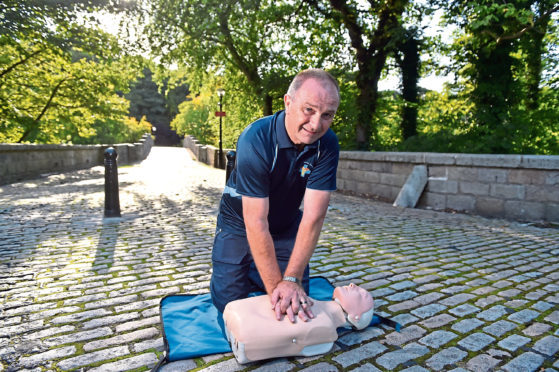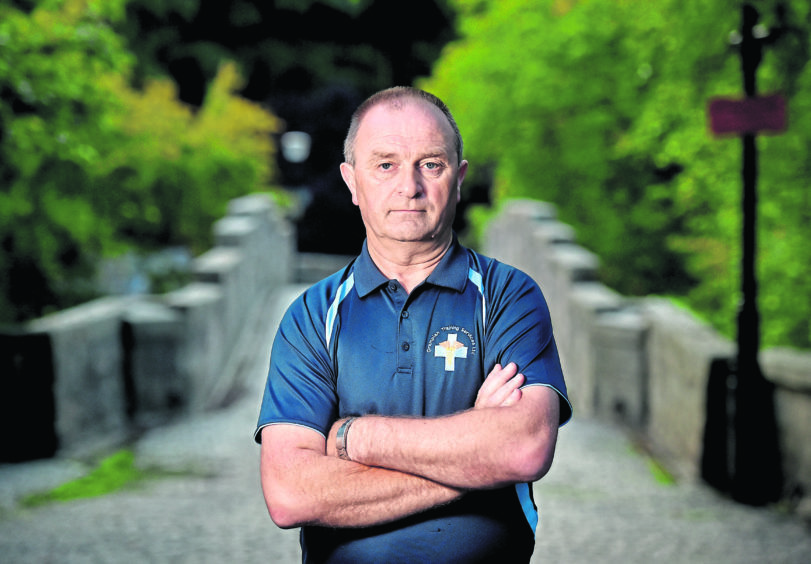When it comes to tightening school budgets, more often than not first aid training is one of the first activities to be dropped. Philippa Gerrard found out the consequences.
“Did you know that only around 12% of adults in Britain have had any first aid training?” mused Tom Malcolm, himself a qualified first aider.
“Elsewhere in Europe it’s as high as 80%,” he said.
“It’s strange that we place so little importance on something which is literally life-saving.”
Now 56, Tom has dedicated his life to saving lives, starting out as an army medic after leaving school.
Various jobs have taken him in different directions over the years, including volunteering with the ambulance service and working with local authorities as a health and safety co-ordinator.
But the Aberdeen resident has spent the past 35 years on a project particularly close to his heart – teaching emergency first aid to children.
“Schools do not have the funding to pay ‘commercial’ training rates for traditional first aid courses,” Tom said. “So as a result, all but a tiny minority have absolutely no first aid training at all.
“The north-east is a very rural population and there are times when even during an emergency, ambulances will not be there within five minutes.
“I find it truly sad that schools have to choose between teaching their pupils life-saving skills or buying playground equipment and library resources.
“But me complaining about it made no difference, so I decided to try and do something about it.”
As an army medic, Tom had been teaching young recruits basic first aid skills since he himself was a young lad.
It gave him a good idea where to start, and on top of his day-to-day life, he soon began volunteering with various aid societies and became a registered first aid trainer with the British Red Cross.
In 1994 he began visiting schools to offer training and in 2009 he took voluntary redundancy from his position at Aberdeen Council to focus on his passion.
“Each year I now visit over 80 schools around the north-east with my company Grampian Training Services (GTS),” Tom said.
“I teach kids from primary five upwards and have seen some amazing results.
“I remember a young boy who came up to me when he was in primary seven and told me his mum had asked him to say thank you to me for showing him how to deal with choking.
“He had used it on his little brother who had something lodged in his throat and was going blue.
“His mum couldn’t manage to clear it but this boy was able to save his brother’s life.
“I also taught a young boy from Fernilea Primary who put his fellow pupil in the recovery position after he was knocked unconscious.
“When the ambulance driver arrived he said in no uncertain terms that this action had likely saved the boy’s life.”
Tom’s programme is a graduated scheme where the children’s skills are developed and reinforced over the years as they progress through the training.
With five children and three grandchildren of his own, Tom is passionate that first aid should be available to all school-age children in Scotland no matter their background.
But he has run into one key problem over the years: money.
“With the current financial constraints, schools are having to balance where they spend their cash,” Tom said.
“Paying for first aid training means that they cannot spend on other items and parent teacher associations only have limited resources.
“Although our costs are extremely low, it essentially means that schools in more deprived areas have no access to first aid training of any kind.
“And the situation is not going to change anytime soon.”
But never having been one to sit back and let injustice occur, Tom is on a mission. “Either we continue with some schools being able to afford it and other schools not, or we do something about it,” he said.
“At GTS we are now offering businesses the opportunity to sponsor a school and put them through their life-saving training.
“The corporate sponsorship would enable local companies to contribute to a worthwhile scheme within their local community and to literally help to save lives.
“There are children in every community and I hope that by training as many pupils as possible, they can help someone in need, whether it be family, friends, neighbours or passers-by, in their time of need.
“The pupils are like sponges and soak up all the information you give them.
“They are very receptive and we shouldn’t dismiss them as being too young to help in an emergency.
“And remember, the youngsters we train today could be saving your life tomorrow.”

